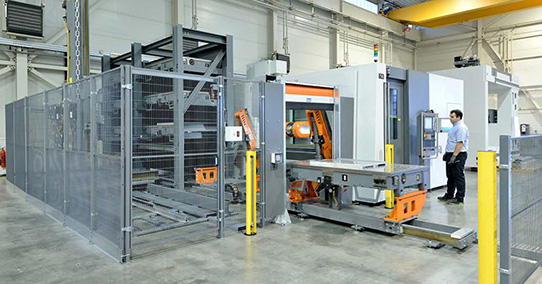Volume 25 | Issue 1
Click here to read the complete illustrated article or continue below to read the text article.
There is no better measurement of business success than customers that remain loyal for over a near half century; Koss Aerospace (then Koss Machine and Tool) began manufacturing metal parts for McDonnell Douglas (which later merged with Boeing) and DeHavilland in 1975 and continues to supply them today in 2022.
While the names have changed over the years, the Koss commitment to best-in-class, on-time delivery of high quality products to the global aerospace and defense industry continues to soar.
Family-owned Koss Aerospace operates three facilities in the greater Toronto region. The company provides complex manufacturing and metal finishing of structural parts for a diverse customer base of OEM and Tier 1 customers encompassing 17 aircraft programs in four segments:
Core competency Koss Aerospace products are primarily used in an aircraft’s wings, fuselage and landing gear. These include:
How does Koss Aerospace continually attain new heights of success ? “As a vertically integrated manufacturer, we offer complete, one-stop shopping manufacturing solutions that offer reduced lead times for on-time delivery with industry-leading KPIs,” notes Alex Cajic, VP of Business Development. The four components of Koss Aerospace vertical integration are:
Key to that capability is continual investment in state-of-the-art automation technology to increase capacity and productivity.

“We invested over $10 million in capital equipment in the five years preceding the pandemic,” Cajic says, “We were the first company in North America, and the only company in Canada, to install an 8 Pallet Bavius Compact Cell to improve machine utilization,” Cajic notes. “Coupled with various other milling machines and pallet systems, we’ve increased capacity by over 40,000 hours annually.”
In addition, implementation of a 5-axis manufacturing cell significantly reduced the required number of operators, saving on labor expense while also boosting productivity.
Another example is the upcoming completion of a robotic automated paint line in its Brampton Processing metal parts finishing center. “Over 80 percent of the parts we supply require painting, so this automation saves additional time while improving output,” Cajic notes.
Along with this automation, Koss Aerospace has evolved into a data-driven organization to better measure the effectiveness of equipment utilization. “The Memex software tool, for example, enables us to collect accurate data to evaluate and optimize manufacturing processes, Cajic notes. “Whatever you can measure, you can control and improve.”
Koss Aerospace also aims to reduce its carbon footprint while maintaining quality. “We are committed to complying with all environment regulations in our industry,“ Cajic says. Case in point is the phasing out of Hexavalent chromium- based anodizing, cleaning and painting and replacing it with more environmentally-friendly processes.
“We are pleased to do our part to protect the environment,’ Cajic says. “We at Koss Aerospace welcome changes in our industry towards achieving higher levels of sustainability.”
Manufacturing during the pandemic presented its own set of unique challenges, though Koss Aerospace did manage to “fly under the radar” in many respects.
“We aren’t over leveraged with debt, “Cajic notes, “and thanks to our diversification in services and customers, we were able to keep our machinery running. For example, our metal finishing business remained busy with our defense customers as did our repair and overhaul segment, which provides plating applications for landing gear components.”
He adds that, “Our metal finishing capabilities offer significant competitive advantage, particularly during this time of supply chain issues during the pandemic. Ninety percent of current Koss Aerospace orders are finished in-house. Since we don’t outsource, we not only offer better quality control, but we can meet quicker delivery times.”
Which is not to say Koss Aerospace didn’t encounter what Cajic characterizes as “industry headwinds” during the pandemic. “Travel bans grounding almost all international flights affected the entire commercial aviation segment. Many of our customers were shutting down initially to ensure worker safety and figure out how to manufacture under pandemic conditions,” Cajic notes. “That meant all their orders for us were put on hold.
He adds, “And it wasn’t just our customers shutting down, it was our suppliers as well. Besides having to rethink our supply chains, material prices skyrocketed, all of which contributed to much longer lead times.”
There was, however, a silver lining. “We did have an overall downturn in business, but we took the opportunity during the downturn to focus on how to improve our lean manufacturing processes to reduce and optimize set-up and cycle time,” Cajic says. “Consequently, we are well-positioned to support what we expect to be a full recovery for the aviation industry in 2023-2024.”
Cajic cites a number of factors that underpin his optimism. “International travel is the most profitable segment for airlines, and as that re-opens these airlines are in a better position to do capital spending. And we’re already seeing domestic travel back at almost 2019 levels. Also, a lot of wealth was created during the last two years, which is going to increase demand for business aviation. Two of our long standing customers, Bombardier and Gulfstream, are already benefiting from this pent up demand, which means more work for us.”
Cajic draws a parallel between the current economic situation and 2009 when airlines placed record orders. “Today in 2022, just as in 2009, interest rates are low and fuel prices high,” he explains. “So airlines are incented to retire older, less fuel efficient aircraft with new aircraft.”
It’s the perfect trajectory for a recovery for everyone in aviation manufacturing. And Koss Aerospace is well-positioned to support that recovery.
In this episode, I sat down with Beejan Giga, Director | Partner and Caleb Emerson, Senior Results Manager at Carpedia International. We discussed the insights behind their recent Industry Today article, “Thinking Three Moves Ahead” and together we explored how manufacturers can plan more strategically, align with their suppliers, and build the operational discipline needed to support intentional, sustainable growth. It was a conversation packed with practical perspectives on navigating a fast-changing industry landscape.